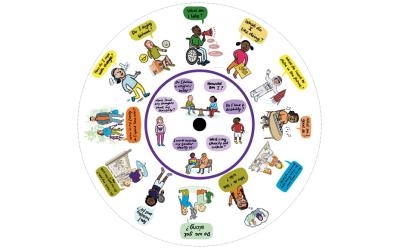Our resources for professionals

On this page you will find information and resources on a range of different topics, mainly covering the tools that Family Court Advisers and Cafcass Guardians use when working with children and families.
The practice aids below are derived from a range of sources and many are not Cafcass original documents. Each practice aid has been identified for use by Cafcass staff. Information on the source of each document is referenced in the further information section below.
Child Impact Assessment Framework
Our Child Impact Assessment Framework (CIAF) brings together the practice guidance, practice aids, references and resources to support FCAs working in all law types, in their social work assessments for children and families.
Direct work with children resources
| Resource | Guidance on use | Source |
|---|---|---|
| ‘Say it your own way’: Children’s participation in assessment: resources | Private/public law: resource of direct work practice aids. Collection of worksheets – some similar with the Cafcass How it looks to me but there are others that can be used to explore the child’s experience at home and in placement. | DfE and Barnardo’s |
| Adapted worry meter | Private/public law: this meter (from a little bit happy to hugely happy) is to be used with the Cafcass emotion stickers to add depth to the feeling the child or young person has picked). | Cafcass practice aid |
| Board game | Private/public law: the aim of the game is to build a sense of trust with the child or young person. The emotions of the board allow them to openly discuss their thoughts and feelings without feeling like they are being questioned. It is made to feel like a game, as the practitioner is intended to join in and share thoughts and feelings. | Cafcass practice aid |
| I’ll go first toolkit | Private/public law: to be used when working with children with disabilities. | The Children's Society |
Observation of Contact: – Observation and Intervention Guidance – Materials for Infants up to One Year – Materials for Children aged One to Five Years | Private/public law: an assessment practice aid which can be used to consider the quality of contact and ability of the parents/carers to meet the child/ren’s needs within this context. | Cafcass practice aids |
Strengths and Difficulties Questionnaire: – Main carer (older child) (DoH Family Pack) - Goodman, 2005, scoring info.
| Private/public law: the Strengths and Difficulties Questionnaire (SDQ) is a brief behavioural screening practice aid to consider whether a child or young person has emotional or behavioural difficulties. The questionnaire can be completed with the parents/carers and also other professionals such as teachers. For adolescents and teenagers there is a questionnaire for self-completion. In community samples, multi-informant SDQs can predict the presence of a psychiatric disorder with good specificity and moderate sensitivity –can be used to evidence the necessity of specific intervention or assessment (expert). | Department of Health 2000: The Family Pack of Questionnaires and Scales. |
| Adolescent wellbeing practice aid (DoH Family) | Private/public law: the Adolescent Wellbeing Scale can be used to consider the wellbeing of older children, the impact on them of their family circumstances and their support needs. As with the Adult Wellbeing assessment practice aid, it is used to consider whether there are problems in regard to depression and anxiety. | DoH 2000 |
| Top tips for professionals from the Family Justice Young People’s Board | The Family Justice Young People’s Board has a range of tips for professionals working for children and young people. | FJYPB |
| Intro leaflet - Working with children with Attention Deficit Hyperactivity Disorder (ADHD) and Oppositional Defiant Disorder (ODD) | Cafcass | |
| Intro leaflet - Working with children with Autism Spectrum Disorder (ASD) | Cafcass | |
| Intro leaflet - Working with children with Downs Syndrome | Cafcass | |
| Intro leaflet - Working with children with Global Development Delay (GDD) | Cafcass | |
| Intro leaflet - Working with children with complex physical disabilities | Cafcass | |
| Intro leaflet - Working with children with sensory impairment | Cafcass | |
| Intro leaflet - Working with children with specific learning difficulties | Cafcass | |
| 'A Day in My life' - a direct work disability practice aid for FCAs | Cafcass |
The diversity wheel can support children and young people to talk about their identity and what is important in their life. The diversity wheel is a graphic representation of protected characteristics, and diversity and uniqueness in its broadest sense. The diversity wheel can be used as an interactive direct work tool with children and young people or as an aide to support our assessment and recommendations to the family court.
My Needs, Wishes and Feelings is one of the tools Cafcass workers use to help a young person share their feelings directly with the court, if they wish to do so. This resource has been developed in consultation with Cafcass workers, external partners and children.
Forms for younger children
- My needs wishes and feelings summary for younger children
- About me for younger children
- Important things that have happened to me for younger children
- Things that make me feel safe for younger children
- What I need now for younger children
- My needs for younger children
- How I feel about my future for younger children
- My plan for younger children
- Express yourself for younger children
- What I want to say for younger children
- Factsheet for younger children
Forms for older children
- My needs wishes and feeling summary for older children
- About me for older children
- Important things that have happened to me for older children
- Things that make me feel safe for older children
- My thoughts for older children
- What I want to happen next for older children
- My needs option 1 for older children
- My needs option 2 for older children
- Feelings about my future option 1 for older children
- Feelings about my future option 2 for older children
- My plan for older children
- Express yourself for older children
- What I want to say for older children
- Factsheet for older children
This tool is designed for practitioners to work through sequentially, gradually building up to talk about potentially more distressing aspects of a child’s life. It can be used as part of a wider safety assessment and analysis and can be disclosed to the court in its own right as a record of what the child has said. The practitioner guidance provides some more information about how this tool should be used.
This tool is not intended for submission to court. Instead, it allows the child to keep a record of their case and their involvement in it for them to look back on in future years, should they choose to do so. The child may choose to complete the sheets by themselves or with the support of the Cafcass worker, their parent or carer or social worker.
| Resource | Guidance on use | Source |
|---|---|---|
| Background to the application | Private law: select these tools to gather information during interviews as required in most applications. | Cafcass |
| Tool for parental concerns about their child | Private law: select these tools to gather information during interviews as required in most applications. | Cafcass – adapted from Fowler, 2003 |
| Tool for review of family and environmental factors | Private law: select these tools to gather information during interviews as required in most applications. | Cafcass – adapted from DoH (date unknown) |
| Tool for criminal history | Private law: select these tools to gather information during interviews as required in most applications. | |
| Home conditions assessment | Private/public law: an assessment tool which can be used if making a home visit where there have been concerns about neglect and poor home conditions. | DoH 2000 |
| Rosenberg self-esteem tool | Private/public law: a 10-item scale that measures global self-worth by measuring both positive and negative feelings about the self. | From Rosenberg, 1965 |
| International resilience project – 15-point checklist for resilience | Private law: to be used during and post interview. | Adapted from Grotberg, 1997 |
| Resilience/Vulnerability Matrix (Calder, 2006) | Private/public law: an analytical tool which can be used to explore the resilience and vulnerability factors in children, which enables an assessment specific to the individual child. | From Gorden et al. (2000) |
Rule 16.4
Our rule 16.4 factsheet for courts details a new approach to private law cases which have been identified as requiring 16.4 appointments, when that has been agreed between Cafcass and courts in England.
Cafcass is not responsible for the contents or reliability of the linked websites and does not necessarily endorse the views expressed within them. Listing shall not be taken as endorsement of any kind. Cafcass cannot guarantee that these links will work all of the time and has no control over the availability of linked pages.
